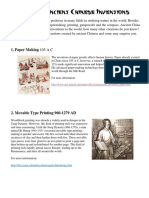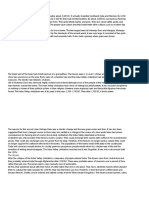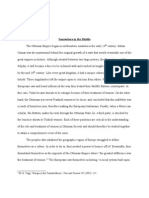0 ratings0% found this document useful (0 votes)
162 viewsIbn Battuta
Ibn Battuta
Uploaded by
Shafia IqbalMuhammad Ibn Battuta (1304-1377 CE) was a Moroccan traveler and writer. Towards the end of 1332, Ibn Battuta came to India via Afghanistan.
Copyright:
© All Rights Reserved
Available Formats
Download as PPTX, PDF, TXT or read online from Scribd
Ibn Battuta
Ibn Battuta
Uploaded by
Shafia Iqbal0 ratings0% found this document useful (0 votes)
162 views12 pagesMuhammad Ibn Battuta (1304-1377 CE) was a Moroccan traveler and writer. Towards the end of 1332, Ibn Battuta came to India via Afghanistan.
Copyright
© © All Rights Reserved
Available Formats
PPTX, PDF, TXT or read online from Scribd
Share this document
Did you find this document useful?
Is this content inappropriate?
Muhammad Ibn Battuta (1304-1377 CE) was a Moroccan traveler and writer. Towards the end of 1332, Ibn Battuta came to India via Afghanistan.
Copyright:
© All Rights Reserved
Available Formats
Download as PPTX, PDF, TXT or read online from Scribd
Download as pptx, pdf, or txt
0 ratings0% found this document useful (0 votes)
162 views12 pagesIbn Battuta
Ibn Battuta
Uploaded by
Shafia IqbalMuhammad Ibn Battuta (1304-1377 CE) was a Moroccan traveler and writer. Towards the end of 1332, Ibn Battuta came to India via Afghanistan.
Copyright:
© All Rights Reserved
Available Formats
Download as PPTX, PDF, TXT or read online from Scribd
Download as pptx, pdf, or txt
You are on page 1of 12
Muhammad Ibn Battuta (1304-1377 CE) was a
Moroccan traveler and writer.
Also known as Shams ad-Din.
Born in Tangier in Morocco in 1304 CE.
Belonged to a family of Qadis (judges) and received an
education in Islamic law.
Ibn Battuta was only 21-year-old when he set out on a
voyage.
But driven by a spirit of adventure, he didn't return
home and decided to travel further and explore far
away foreign lands.
Over the next 30 years, he would visit North Africa, the
Horn of Africa, West Africa, the middle east, India,
central Asia, South-East Asia and Chine before
returning home in 1354 CE.
Towards the end of 1332, Ibn Battuta came to India via
Afghanistan.
He is said to have crossed the Indus river on 12
September 1333 CE and made his way to Delhi
India was then ruled by Muhammad bin Tughluq, then
considered to the wealthiest man in the Islamic world.
The Sultan of Delhi, was impressed by his scholarship
and appointed him as the Qazi or judge of Delhi with a
salary of 12,000 dinars per year.
In 1342, he was sent proceed to china as the Sultan’s
envoy to the Mongol ruler.
By the time Ibn Battuta arrived in Delhi in the fourteenth
century, the subcontinent was part of a global network of
communication that stretched from China in the east to north-
west Africa and Europe in the west.
He enjoyed spending time with learned men and rulers, often
officiating as qazi, and enjoying the cosmopolitan culture of
urban centers. Anything that was unfamiliar was particularly
highlighted to impress the readers or listeners.
The state evidently took special measures to encourage
merchants.
All trade routes were well supplied with inns and guest houses.
He was amazed by the efficiency of the postal system which
allowed merchants to not only send information and remit credit
across long distances, but also to dispatch goods required at
short notice.
Battuta found the cities in the subcontinent with full of exciting
opportunities for those who had the necessary drive, resources
and skills.
They were densely populated and prosperous. Most cities had
crowed streets and bright and colorful markets with wide variety
of goods.
He describes Delhi as a vast city, with a great population, the
largest in India.
The bazaars were not only places of economic transactions, but
the hub of social and cultural activities.
Most bazaars had a mosque and a temple and space were marked
for public performances by dancers, musicians and singers.
He found Indian agriculture very productive because of the
fertility of soil.
Ibn Battuta described a royal meal:
Bread (in thin round cakes); large slabs of meat (sheep);
Meat cooked with ghee, onions and green ginger;
Rice cooked in ghee with chicken on top;
“Sambusak" (triangular pastries made of hashed meat
and cooked with almonds, walnuts, pistachios, onions,
and spices put inside a piece of thin bread fried in ghee -
also known as "samosas");
Sweetcakes and sweetmeats (pastries) for dessert;
They drank sherbet of sugared water before the meal
and barley-water after.
These are samosas or as Ibn Battuta called
them – ‘sambusak’.
These are betel leaves for sale at a modern
market. They are still grown and chewed
(along with areca nuts).
After he returned home, the Marinid
ruler of Morocco, Abu Inan Faris,
persuaded him to document his travel
experience.
Ibn Battuta dictated an account of his
journeys to a scholar named Ibn
Juzayy
A Gift to Those Who Contemplate the
Wonders of Cities and the Marvels of
Travelling, but is often simply referred
to as the Rihla, or "Journey".
Fictional in places, the Rihla still gives
as complete an account as exists of
some parts of the world in the 14th
century.
“Traveling—it
leaves you speechless,
then turns you into a
storyteller.”
― Ibn Battuta
The travels of Ibn Battutah
You might also like
- Age of AbsolutismDocument5 pagesAge of Absolutismhrnrfd100% (1)
- An Age of AdventureDocument3 pagesAn Age of Adventureapi-327452561100% (3)
- BRITISH HISTORY NotatkiDocument6 pagesBRITISH HISTORY NotatkiIgor DudzikNo ratings yet
- Absolutism Ends in England Reading AnswersDocument5 pagesAbsolutism Ends in England Reading AnswersAlexie Fonseca-Rodriguez - StudentNo ratings yet
- Ancient China Geography 1aDocument2 pagesAncient China Geography 1aapi-205540374100% (1)
- VCE History Revolutions Chinese - Units3&4 AOS1 - Lesson 13 - The Ya'an Way PDFDocument27 pagesVCE History Revolutions Chinese - Units3&4 AOS1 - Lesson 13 - The Ya'an Way PDFnicNo ratings yet
- Indian Ocean Trade Short Answer Question PracticeDocument2 pagesIndian Ocean Trade Short Answer Question Practiceapi-39087829863% (8)
- Chinese Inventions ArticleDocument8 pagesChinese Inventions Articleapi-286159600No ratings yet
- Kublai KhanDocument10 pagesKublai KhanMonica Reyes100% (1)
- Ancient IndiaDocument22 pagesAncient IndiaAnmol JainNo ratings yet
- River Valley Civilizations Day 3 1Document23 pagesRiver Valley Civilizations Day 3 1api-294843376No ratings yet
- CH 5 Sec 4 - Alexander's Empire PDFDocument4 pagesCH 5 Sec 4 - Alexander's Empire PDFJ. Nieves100% (2)
- The Crusades KeynoteDocument25 pagesThe Crusades KeynoteValentin Tino NikoloskiNo ratings yet
- CH 10 Sec 3 - Muslim Culture PDFDocument7 pagesCH 10 Sec 3 - Muslim Culture PDFJ. NievesNo ratings yet
- Colonial America OutlineDocument2 pagesColonial America Outlineapi-293174357No ratings yet
- A Brief History of India - Local HistoriesDocument8 pagesA Brief History of India - Local HistoriesJRavi PsNo ratings yet
- Absolutism and Constitutional IsmDocument24 pagesAbsolutism and Constitutional IsmTin LuuNo ratings yet
- England Nation State King Henry VII and VIIIDocument16 pagesEngland Nation State King Henry VII and VIIIapi-440272030100% (1)
- The Middle AgesDocument3 pagesThe Middle Agesapi-324326027No ratings yet
- Earliest Human PresenceDocument17 pagesEarliest Human PresenceSharmin AkterNo ratings yet
- Renaissance PowerpointDocument34 pagesRenaissance Powerpointapi-248620271No ratings yet
- Leading Figures of The Renaissance TextDocument22 pagesLeading Figures of The Renaissance Textapi-233464494No ratings yet
- Ancient Roman ArchitectureDocument15 pagesAncient Roman ArchitectureAzrudin AnsariNo ratings yet
- The Middle Ages of EuropeDocument7 pagesThe Middle Ages of Europe20-67 Jugal RajNo ratings yet
- Industrial Revolution Study GuideDocument1 pageIndustrial Revolution Study GuideEamon BarkhordarianNo ratings yet
- The Late Middle AgesDocument10 pagesThe Late Middle Agesgabi100% (1)
- Greek Civilization: Reported By: Aaron Masaganda Hist 02 (World History)Document83 pagesGreek Civilization: Reported By: Aaron Masaganda Hist 02 (World History)Arvin Jonathan Moyon RetuyaNo ratings yet
- Eyewitness China PDFDocument2 pagesEyewitness China PDFAnthony0% (1)
- Ancient India: The Indus PeopleDocument2 pagesAncient India: The Indus PeopleGina Morales de FernándezNo ratings yet
- Lesson Plan 2 1Document2 pagesLesson Plan 2 1api-485133582No ratings yet
- Kristallnacht: Night of Broken GlassDocument17 pagesKristallnacht: Night of Broken GlassLewis NelsonNo ratings yet
- 28.the Mongol EmpireDocument5 pages28.the Mongol EmpireKayeden CubacobNo ratings yet
- Summary: Conquest of The Americas: Cortés Conquers The AztecsDocument1 pageSummary: Conquest of The Americas: Cortés Conquers The AztecsLigia-Ioana DancusNo ratings yet
- The Travels of Marco Polo Reading ExerciseDocument4 pagesThe Travels of Marco Polo Reading ExerciseSandra LEON MORENONo ratings yet
- Chapter 14 VocabularyDocument23 pagesChapter 14 VocabularyNicholas FarratNo ratings yet
- Origins and Nature of The Russian EmpireDocument27 pagesOrigins and Nature of The Russian Empire12 25100% (1)
- World History Important DateDocument3 pagesWorld History Important DateHabib ManzerNo ratings yet
- Human Geography Unit One NotesDocument5 pagesHuman Geography Unit One NotesOnyekachukwu Idiaghe100% (1)
- World War II NotebookDocument7 pagesWorld War II Notebookapi-130087742No ratings yet
- Activity Sheet - Ancient China IntroductionDocument4 pagesActivity Sheet - Ancient China Introductionfruittingles100% (1)
- Silk Road ActivityDocument18 pagesSilk Road Activityapi-332313139No ratings yet
- River Valley Civilizations - MesopotamiaDocument13 pagesRiver Valley Civilizations - Mesopotamiaapi-294843376No ratings yet
- CHAPTER 12 OUTLINE Mongol Eurasia and Its AftermathDocument6 pagesCHAPTER 12 OUTLINE Mongol Eurasia and Its AftermathzionNo ratings yet
- Famous ExplorersDocument5 pagesFamous Explorersswanil_choksiNo ratings yet
- Notes - Battles of The American Revolutionary War - Rank em - ws-1Document2 pagesNotes - Battles of The American Revolutionary War - Rank em - ws-1api-236682830No ratings yet
- Chap 25Document28 pagesChap 25api-240900456No ratings yet
- Ancient Greek CivilizationDocument50 pagesAncient Greek CivilizationKriti KumariNo ratings yet
- Terracotta Army Cultural SignificanceDocument5 pagesTerracotta Army Cultural Significanceggwp21No ratings yet
- AP Euro Topic Guide 2.6Document2 pagesAP Euro Topic Guide 2.6Moez BouaziziNo ratings yet
- A List of Ancient Roman InventionsDocument4 pagesA List of Ancient Roman InventionsJack LordNo ratings yet
- Egyptian CivilizationDocument11 pagesEgyptian CivilizationnbvNo ratings yet
- Jigsaw Share Activity SampleDocument3 pagesJigsaw Share Activity Sampleapi-321836010No ratings yet
- Copyof 3 Empiresguidednotes 2016Document9 pagesCopyof 3 Empiresguidednotes 2016api-335205448No ratings yet
- Bulacan State University in Consortium of Mdsi: A Project in Soc Sci 123 (Geography) Ms. Jamaica Rafol MARCH 2014 BYDocument50 pagesBulacan State University in Consortium of Mdsi: A Project in Soc Sci 123 (Geography) Ms. Jamaica Rafol MARCH 2014 BYBernardo Villavicencio VanNo ratings yet
- The Scientific RevolutionDocument3 pagesThe Scientific Revolutionapi-508882599No ratings yet
- The LeverDocument12 pagesThe LeverAL Jeff PuguonNo ratings yet
- Imperialism, World War, and RevolutionDocument34 pagesImperialism, World War, and Revolutionapi-286746886No ratings yet
- World History Spring Final Exam ReviewDocument5 pagesWorld History Spring Final Exam ReviewBrian RobertsNo ratings yet
- Class 12 THEMES IN INDIAN HISTORY 2 PDFDocument179 pagesClass 12 THEMES IN INDIAN HISTORY 2 PDFAkashdeep SinghNo ratings yet
- DBQ EssayDocument3 pagesDBQ Essayapi-319153490No ratings yet
- India Overseas TradeDocument2 pagesIndia Overseas TradePraneel BhattNo ratings yet
- Every Child Is An Artist. The Problem Is How To Remain An Artist Once We Grow Up Pablo PicassoDocument4 pagesEvery Child Is An Artist. The Problem Is How To Remain An Artist Once We Grow Up Pablo PicassoAshot GrigoryanNo ratings yet
- Ibn BattutaDocument10 pagesIbn BattutaJennifer WangNo ratings yet
- Explorations An OpenInvitationToBiologicalAnthropologyDocument713 pagesExplorations An OpenInvitationToBiologicalAnthropologycNo ratings yet
- Exercise English Unit 7 and 8Document3 pagesExercise English Unit 7 and 8andryNo ratings yet
- From Hadhramaut To Sylhet To White Chapel - Habib Ali Al-JifriDocument14 pagesFrom Hadhramaut To Sylhet To White Chapel - Habib Ali Al-JifriRadical Middle WayNo ratings yet
- Ibn Battutah Meeting Shah JalalDocument5 pagesIbn Battutah Meeting Shah JalalHadee SaberNo ratings yet
- DelhiDocument29 pagesDelhiJag AquaNo ratings yet
- Through The Eyes of TravellersDocument13 pagesThrough The Eyes of TravellersRamita Udayashankar100% (4)
- Ibn BatutaDocument10 pagesIbn BatutasaraNo ratings yet
- Fakhruddin and Ibn BATUTADocument7 pagesFakhruddin and Ibn BATUTAToushib ChakmaNo ratings yet
- E4.- Worksheets new محلولةDocument5 pagesE4.- Worksheets new محلولةabdelhadya31No ratings yet
- About Ibn Battuta (1304 - 1369)Document16 pagesAbout Ibn Battuta (1304 - 1369)Ajay TomarNo ratings yet
- Presentation On Ancient TravellersDocument23 pagesPresentation On Ancient TravellersSanjana AhujaNo ratings yet
- (PDF Download) Understanding Children's Development 6th by Peter K. Smith Fulll ChapterDocument34 pages(PDF Download) Understanding Children's Development 6th by Peter K. Smith Fulll Chapterlaweepichek100% (6)
- Age of ExplorationDocument30 pagesAge of ExplorationOscar AlfaroNo ratings yet
- Essay The FirstDocument5 pagesEssay The FirstMatthieu LabaudinièreNo ratings yet
- WHAP Chapter 8 Notes PartIIDocument39 pagesWHAP Chapter 8 Notes PartIIDuezAP100% (3)
- Treasures of The Aga Khan MuseumDocument292 pagesTreasures of The Aga Khan MuseumFf Ss100% (1)
- Minimum Level Learning Material For Class XII History (2024-25)Document30 pagesMinimum Level Learning Material For Class XII History (2024-25)niharikahere.07No ratings yet
- Postcolonialism and Travel Writing: GarethgriffithsDocument23 pagesPostcolonialism and Travel Writing: GarethgriffithsMatheus MenezesNo ratings yet
- Model Paper: Student Name (In Capital Letters) For Official Use Only Total Marks McqsDocument4 pagesModel Paper: Student Name (In Capital Letters) For Official Use Only Total Marks McqsShakila YasmeenNo ratings yet
- Ibn e Battuta PDFDocument9 pagesIbn e Battuta PDFSaeed HashmiNo ratings yet
- Ibn Battuta Salt MinesDocument2 pagesIbn Battuta Salt MinesDavid DuezNo ratings yet
- World TravelerDocument2 pagesWorld TravelerRicky FavelaNo ratings yet
- Discovering A World of Change and Challenge in The Footsteps of The 14th Century Explorer Ibn BattutaDocument2 pagesDiscovering A World of Change and Challenge in The Footsteps of The 14th Century Explorer Ibn BattutaKemal EsmerNo ratings yet
- Ibn Battuta: A Lifetime of ExplorationDocument4 pagesIbn Battuta: A Lifetime of ExplorationA ANo ratings yet

























































































